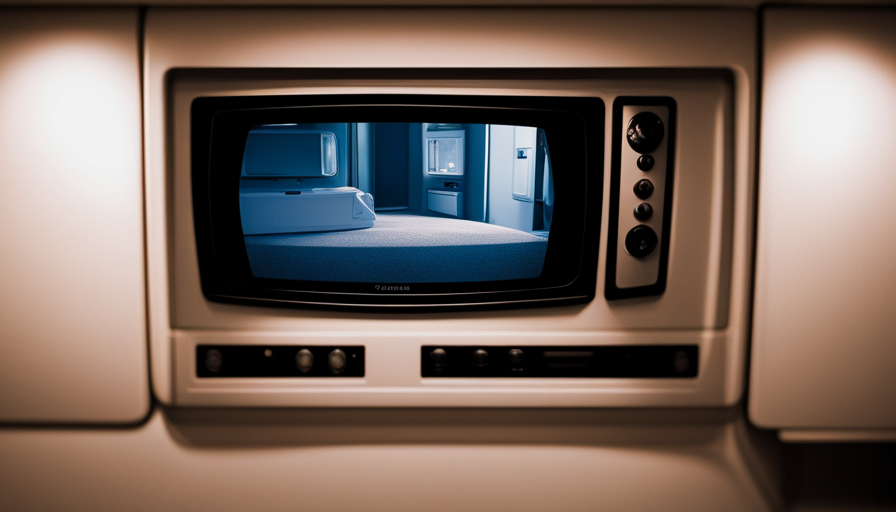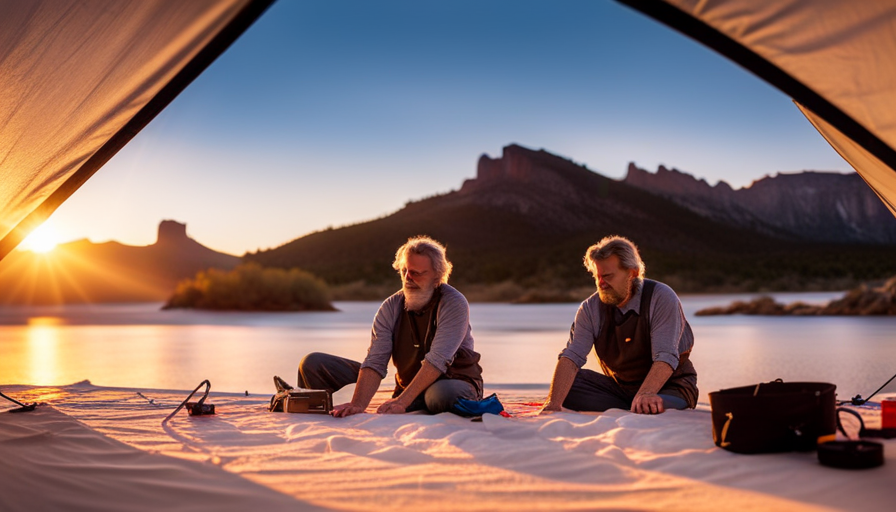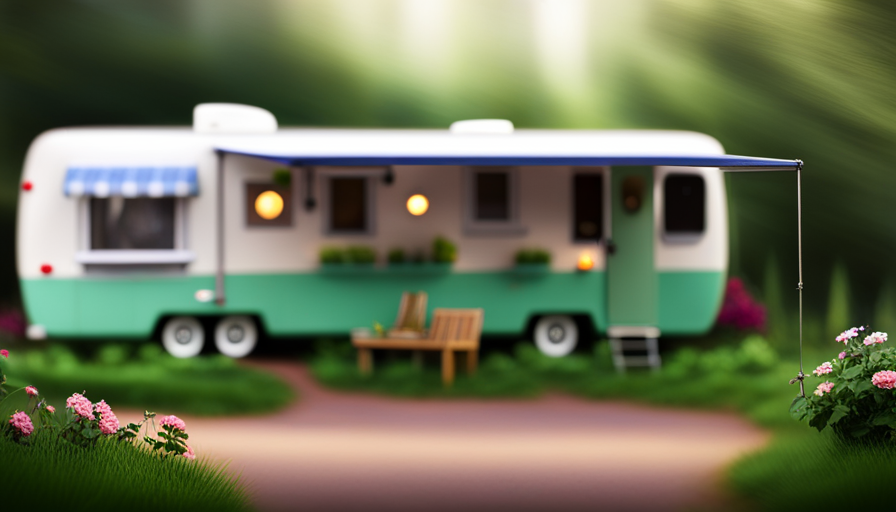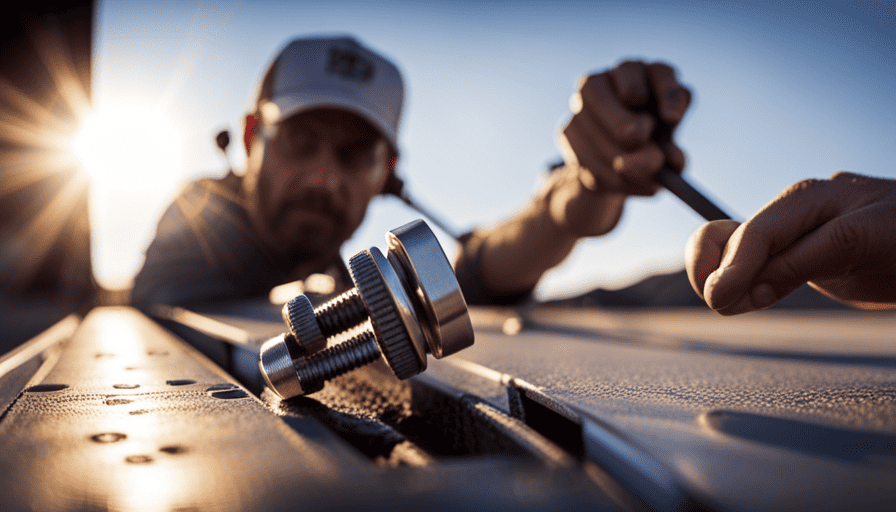Adding a TV to your RV can greatly enhance your outdoor adventures by providing entertainment and a way to relax after a day of exploring. Just like a compass guides you through unfamiliar terrain, this comprehensive guide will help you easily navigate the installation process.
With the right tools and materials at hand, you can transform your camper into a portable entertainment hub. From assessing the layout of your camper to securing loose cables and wires, every step is crucial to ensure a safe and enjoyable TV mounting experience.
Whether you’re a seasoned camper or a novice explorer, this article will walk you through each stage, empowering you to take control of your outdoor entertainment. So, grab your tools and let’s embark on a journey to mount a TV in your camper – a journey that will bring comfort and joy to your camping adventures.
Key Takeaways
- Assess the layout of the camper to find the perfect spot for mounting the TV, considering space, viewing angles, and obstructions.
- Gather the necessary tools and materials, such as a mounting bracket designed for the TV model and camper type, appropriate screws and anchors, a power drill, and a screwdriver.
- Carefully attach the mounting bracket to the wall, ensuring accurate placement by marking and drilling pilot holes before securing the bracket.
- Mount the TV onto the bracket, aligning the mounting holes and tightening the screws to securely attach the TV. Adjust the angle of the TV for optimal viewing.
Assess the Layout of Your Camper
Take a moment to assess the layout of your camper and envision the perfect spot to mount your TV for the ultimate entertainment experience on the road.
Start by assessing the available space in your camper. Look for a wall or surface that can accommodate the size and weight of your TV. Consider the viewing angles and make sure the spot you choose allows for comfortable viewing from different areas in the camper.
Additionally, take into account any obstructions such as windows, cabinets, or appliances that may affect the visibility of the TV.
Optimizing the layout is crucial for a successful TV mount installation. Consider the height at which you want the TV to be mounted. It should be at eye level when seated in the typical viewing area. Take measurements to ensure the TV will fit in the chosen spot and that there is enough clearance for any necessary cables or connections.
Once you have assessed the space and optimized the layout, it’s time to gather the necessary tools and materials for the installation.
Gather the Necessary Tools and Materials
To successfully mount a TV in your camper, you’ll need a few essential tools and materials.
First, you’ll need a mounting bracket specifically designed for your TV model and camper type. This bracket will ensure a secure and stable installation.
Next, you’ll need screws and anchors suitable for the type of wall or surface you’ll be mounting the TV on. These will provide the necessary support and prevent the TV from falling.
Lastly, a power drill and screwdriver will be required to attach the bracket and screws securely. These tools will allow you to drill pilot holes and tighten the screws effectively for a professional-looking installation.
Mounting Bracket
Grab a cold one and let me show you how easy it is to slap that TV on a mounting bracket in your camper! When it comes to the mounting bracket, you have a few options to choose from. Take a look at the table below to compare the different options based on their weight capacity and features:
| Bracket Type | Weight Capacity | Features |
|---|---|---|
| Fixed | Up to 100 lbs | Simple and sturdy design |
| Tilting | Up to 75 lbs | Allows for vertical adjustment |
| Full Motion | Up to 50 lbs | Provides full range of motion |
Now that you have an idea of the different mounting options, you can choose the one that best suits your needs. Once you’ve selected the bracket, we can move on to the next step of securing it to the wall using screws and anchors.
Screws and Anchors
Now let me walk you through how easily you can secure the mounting bracket to the wall using screws and anchors.
When it comes to screws and anchors, there are a few alternatives you can consider. For lightweight TVs, you can use plastic anchors and screws that are specifically designed for drywall. These are easy to install and provide sufficient support. However, for heavier TVs, it’s recommended to use toggle bolts or molly bolts, which offer better weight-bearing capacity.
Before deciding on the type of screw and anchor to use, make sure to consider the weight of your TV to ensure proper support. Once you’ve selected the appropriate screws and anchors, you can proceed to attach the mounting bracket to the wall.
Now, let’s move on to the next step, which involves using a power drill and screwdriver.
Power Drill and Screwdriver
Using a power drill and screwdriver is a piece of cake when it comes to securing the mounting bracket to the wall. However, before using any power tool, it is crucial to prioritize power drill safety. Always wear safety goggles and gloves to protect yourself from flying debris. Additionally, make sure the power drill is in good condition and the battery is fully charged. Now, let’s talk about choosing the right screws for the job. For mounting a TV in a camper, it’s important to use screws that are long enough to securely hold the weight of the TV and mounting bracket. Look for screws that are at least 2 inches in length and have a diameter that matches the mounting holes on the bracket. This will ensure a strong and secure installation. Moving on to the next step, let’s install the mounting bracket securely onto the wall.
Install the Mounting Bracket
To install the mounting bracket, the first step is to mark the drill holes on the wall where the bracket will be attached. Use a level to ensure the bracket will be straight.
Next, drill pilot holes into the marked spots to make it easier to screw in the mounting screws.
Finally, attach the bracket to the wall by aligning the drilled holes with the mounting screws and tightening them securely.
Mark the Drill Holes
First things first, let’s grab our marker and carefully mark the drill holes for mounting the TV in your camper. To ensure accurate placement, it’s crucial to use proper drilling techniques and precise measurements. Here’s a step-by-step guide to marking the drill holes:
| Step | Instructions |
|---|---|
| 1 | Measure and mark the desired height for your TV mount on the wall. |
| 2 | Use a level to ensure the mark is straight and aligned with your viewing preference. |
| 3 | Locate the studs behind the wall using a stud finder and mark their positions. |
| 4 | Determine the spacing between the mounting holes on the TV bracket and mark them accordingly. |
By carefully following these steps, you’ll have the drill holes accurately marked for mounting your TV. Now, let’s move on to the next section and learn how to drill pilot holes for a secure installation.
Drill Pilot Holes
Before drilling pilot holes, make sure to properly mark the drill holes on the wall. This ensures accuracy and prevents any mistakes during the mounting process. Now, let’s move on to drilling pilot holes.
-
Begin by preparing the wall surface where you’ll be mounting the TV bracket. Clean the area and remove any dust or debris.
-
Choose the right screws for your camper wall. Make sure they’re suitable for the type of wall material and capable of supporting the weight of your TV.
-
Hold the bracket against the marked drill holes and align it properly.
-
Using a drill bit slightly smaller than the screws, carefully drill pilot holes at the marked spots. Be cautious not to drill too deep or damage the wall.
With the pilot holes drilled, we’re now ready to attach the bracket to the wall securely.
Attach the Bracket to the Wall
Once you’ve successfully drilled the pilot holes, it’s time to securely attach the bracket to the wall, giving your TV a sturdy and reliable foundation.
Before you begin, make sure you’ve chosen the appropriate mounting option for your camper. There are various types of TV brackets available, such as fixed, tilting, or full-motion brackets. Consider the weight capacity of the bracket and ensure it can support the weight of your TV.
Start by holding the bracket against the wall in the desired position. Use a level to make sure it’s perfectly straight. Mark the screw hole locations with a pencil.
Next, use the appropriate screws and a screwdriver or drill to secure the bracket to the wall. Make sure the screws are tight and the bracket is securely attached.
Now that the bracket is in place, you’re ready to mount the TV onto it, which we’ll discuss in the next section.
Mount the TV onto the Bracket
To securely attach the TV to the bracket, you’ll need to carefully align the mounting holes with the corresponding slots on the back of the TV. Start by placing the TV face down on a soft surface to avoid scratching the screen.
Locate the mounting holes on the back of the TV and align them with the holes on the bracket. Insert the screws into the holes and tighten them using a screwdriver. Make sure the screws are secured tightly to ensure the TV stays in place.
Once the TV is mounted onto the bracket, you can adjust the screen angle to your desired position. Most brackets allow for tilting and swiveling, so you can achieve the optimal viewing angle. Use the adjustment knobs or levers on the bracket to make these adjustments. Take your time to find the perfect angle that suits your needs.
In addition to mounting the TV, it’s important to consider cable management techniques. Start by routing the cables through the cable management clips or channels on the bracket. This will help keep the cables organized and prevent them from tangling or getting in the way. Use zip ties or cable wraps to secure the cables in place.
With the TV securely mounted and the cables managed, you can now move on to connecting the cables and power source. This step will ensure that your TV is ready for use in your camper.
Connect the Cables and Power Source
To connect the cables and power source for your mounted TV in a camper, first, locate the HDMI and audio cables.
Connect one end of the HDMI cable to the HDMI port on the TV and the other end to the HDMI port on your media device.
Next, connect the audio cables from the media device to the audio input on the TV.
Finally, plug in the power cord for the TV into a nearby power outlet or use an extension cord if necessary.
Ensure all connections are secure before powering on the TV.
HDMI and Audio Cables
Make sure you have the right HDMI and audio cables for your camper TV setup, so you can enjoy your favorite shows and movies on the road!
When it comes to HDMI cable management, it’s important to choose a cable that is long enough to reach from your TV to the source device, such as a DVD player or streaming device. Measure the distance and select a cable with the appropriate length to avoid any tangles or strain on the cables.
In addition, consider using cable management solutions, such as cable ties or adhesive clips, to keep the cables neat and organized. Another important aspect is the audio cable length. Ensure that the audio cable is long enough to connect your TV to any external speakers or sound systems in your camper.
With the right cables and proper cable management, you can create a seamless entertainment experience in your camper.
Now, let’s move on to the next step, which is connecting the power cord.
Power Cord
Now that we’ve covered HDMI and audio cables, let’s move on to the power cord for mounting a TV in a camper.
When it comes to power cord options, there are a few things to consider. First, determine the length of the cord you’ll need to reach the nearest power source. Second, decide if you want a detachable power cord or a fixed one. Detachable cords offer more flexibility, but fixed cords can be more secure.
Once you’ve chosen the right power cord, it’s important to think about cable management. Use cable clips or zip ties to keep the cord neatly secured along the wall or furniture. This will prevent any tripping hazards and give your camper a clean appearance.
With the power cord in place, we can now move on to adjusting and positioning the TV for optimal viewing.
Adjust and Position the TV
First, find the perfect spot and adjust the TV like a puzzle piece, sliding it gently into place until it fits snugly on the mount. To ensure optimal viewing experience, it’s crucial to adjust the screen brightness. Locate the brightness control on the TV or use the remote to navigate to the settings menu. Increase or decrease the brightness level according to your preference. Remember, a comfortable viewing experience is essential during long trips.
Next, position the TV at eye level for maximum comfort. This’ll prevent neck strain and provide a more enjoyable viewing experience. Adjust the mount’s height or angle until the TV is directly at eye level. Ensure that the mount is securely fastened to avoid any accidents while the camper is in motion.
Once the TV is in the perfect position, it’s time to test it and adjust the settings. Turn on the TV and navigate through the menu to fine-tune the picture and sound settings. Adjust the contrast, color, and sharpness to your liking. Don’t forget to set the sound to an appropriate level for your surroundings.
By following these steps, you can easily adjust and position the TV in your camper. Now, let’s move on to the next section and test the TV settings to ensure an optimal viewing experience.
Test the TV and Adjust Settings
To truly enhance your viewing experience, it’s time to put the TV to the test and fine-tune its settings, ensuring every detail on the screen comes to life. First, test different TV settings to find the optimal picture quality. Use the remote control to access the TV’s menu and explore options such as brightness, contrast, color, and sharpness. Adjust these settings to your preference, but keep in mind that overly vibrant colors or excessive sharpness can distort the image.
To troubleshoot common TV mounting issues, refer to the following table:
| Problem | Possible Solution |
|---|---|
| TV not turning on | Check power connection and ensure the TV is properly plugged in. Try a different outlet. |
| No sound | Ensure the TV’s volume is turned up and not muted. Check audio cables for any loose connections. |
| Poor signal reception | Adjust the antenna or consider using a signal booster. Check cable connections for any damage. |
| Picture not centered or aligned | Access the TV’s settings menu and use the remote to adjust the picture position, size, and alignment. |
Once you have tested the TV and adjusted the settings, it’s time to secure loose cables and wires to ensure a clean and organized setup.
Secure Loose Cables and Wires
Once you’ve adjusted the TV settings, take a moment to secure any loose cables and wires. This will create a neat and organized setup that resembles a well-tailored suit. Proper cable management not only enhances the visual appeal of your mounted TV but also ensures safety and prevents potential damage to the cables.
To hide the cables, start by identifying the best path to route them. Look for existing holes or channels in the walls or cabinets that can accommodate the cables. If necessary, use a stud finder to locate the studs and avoid drilling into them.
Once you have determined the path, use cable clips or adhesive cable management channels to secure the cables along this route. These clips and channels can be easily attached to the walls or furniture using screws or adhesive backing.
Make sure to leave enough slack in the cables to allow for movement of the TV or any future adjustments. Once all the cables are neatly secured, you can move on to considering additional features and accessories for your camper TV setup.
Consider Additional Features and Accessories
When considering additional features and accessories for mounting a TV in a camper, there are two key points to keep in mind: the sound system or speakers, and the TV mounting arm or bracket.
For a complete entertainment experience, it’s important to invest in a good quality sound system or speakers that can enhance the audio output of the TV.
Additionally, selecting the appropriate TV mounting arm or bracket is crucial to ensure secure and stable installation, allowing for easy adjustment and optimal viewing angles.
Sound System or Speakers
Imagine enjoying your favorite tunes on the road with a top-notch sound system or speakers in your camper! To enhance your audio experience, consider adding wireless speakers with Bluetooth connectivity. Here’s why they’re a must-have for your camper:
-
Convenience: Wireless speakers eliminate the hassle of tangled cords and allow for easy placement anywhere in your camper.
-
Versatility: With Bluetooth connectivity, you can easily connect your smartphone or other devices to the speakers, giving you access to a wide range of music options.
-
Portability: Wireless speakers are compact and lightweight, making them easy to carry and move around as needed.
Now that you have a fantastic sound system in place, it’s time to move on to the next step: choosing a TV mounting arm or bracket.
TV Mounting Arm or Bracket
Now that we have discussed the sound system or speakers for your camper, let’s move on to the next step: choosing the right TV mounting arm or bracket. When it comes to mounting your TV in a camper, there are a few options to consider. One popular choice is a full-motion TV mount, which allows you to adjust the viewing angle and position of the TV. This is especially useful if you have limited space or want to watch TV from different areas of the camper. Another option is a fixed TV mount, which securely holds the TV in place without any movement.
To help you compare these options, here is a table outlining their features:
| TV Mounting Option | Features |
|---|---|
| Full-Motion TV Mount | Adjustable viewing angle and position |
| Fixed TV Mount | Securely holds TV in place without movement |
When installing your chosen TV mount, make sure to follow the manufacturer’s instructions carefully. Ensure that the mount is securely attached to a sturdy part of the camper’s wall or ceiling. Use appropriate tools and hardware to ensure a safe and stable installation.
With the TV mounting arm or bracket in place, you’re now ready to move on to the next step: enjoying your outdoor entertainment.
Enjoy Your Outdoor Entertainment
To fully enjoy your outdoor adventures, you’ll want to mount a TV in your camper. When it comes to outdoor TV placement, it’s important to consider the weather conditions and choose weatherproof TV options.
First, you’ll need to select a suitable location for your outdoor TV. Look for a spot that provides a clear view while considering the angle and distance from your seating area. Make sure there aren’t any obstructions that could block the view or cause damage to the TV.
Next, choose a weatherproof TV that can withstand the elements. Look for TVs with an IP rating of at least IP65, which ensures protection against dust and water. These TVs are designed to withstand rain, humidity, and temperature fluctuations, making them perfect for outdoor use.
Once you have your TV, it’s time to mount it in your camper. Start by attaching the mounting bracket to the back of the TV using the provided screws. Make sure the bracket’s securely attached.
Then, locate the desired mounting spot in your camper and mark the holes for the brackets. Drill pilot holes and attach the brackets securely to the camper wall using screws.
Carefully lift the TV and slide it onto the brackets. Make sure it’s securely in place before releasing it. Adjust the angle of the TV for optimal viewing and tighten any screws or bolts as needed.
Now you’re all set to enjoy your outdoor entertainment in your camper!
Frequently Asked Questions
How do I determine the appropriate size of the TV for my camper?
To determine the appropriate size TV for your camper, consider the available space and viewing distance.
Measure the area where you plan to mount the TV, ensuring it fits without obstructing any important components.
Determine the optimal viewing distance by multiplying the TV’s diagonal measurement by 1.5. This will provide a comfortable viewing experience.
Additionally, ensure the TV mount is compatible with your camper by checking its weight capacity and VESA mounting pattern.
Can I mount a TV in any area of my camper, or are there specific locations that are better suited?
When considering mounting options for a TV in a camper, it’s important to keep in mind weight restrictions and the overall layout of the space. Certain locations may be better suited for mounting a TV, such as a sturdy wall or cabinet.
Ensure that the chosen area can support the weight of the TV and any additional mounting hardware. It’s also crucial to consider cable management and accessibility for viewing angles.
What are the different types of mounting brackets available, and how do I choose the right one for my TV and camper?
When choosing a TV mounting bracket for your camper, it’s important to consider the different types available.
There are three common types: fixed, tilting, and full-motion. Fixed brackets are ideal for a stable and secure installation.
Tilting brackets allow you to adjust the angle of the TV for optimal viewing.
Full-motion brackets offer the most flexibility, allowing you to swivel and tilt the TV in any direction.
Consider the size and weight of your TV, as well as the mounting surface in your camper, before selecting the appropriate bracket.
Are there any special considerations or precautions I should take when mounting a TV in a camper?
When mounting a TV in a camper, there are a few special considerations to keep in mind. Firstly, make sure to plan the wiring route carefully and use appropriate cables for a safe and reliable connection. Secondly, opt for a sturdy and adjustable mount that can withstand the constant motion and vibrations that occur while driving.
Remember to take into account the impact of vibrations and movement on the TV mount. This will ensure that the TV remains securely in place while on the road.
How can I ensure a stable and secure installation of the TV mount in my camper?
To ensure a stable and secure installation of the TV mount in my camper, I first take stability precautions. I carefully assess the wall structure, ensuring it can support the weight of the TV.
Then, I gather the necessary installation tools: a stud finder, level, drill, and screws. After locating the studs, I mark their positions and attach the mount securely.
This meticulous process guarantees a rock-solid TV installation in my camper.
Is There a Specific Method for Mounting a TV in a Camper as Opposed to a Regular Home?
Yes, there is a specific method for mounting a TV in a camper as opposed to a regular home. The process may require special brackets and tools to ensure the TV is secure during travel. For a step-by-step guide, you can find a helpful “mount tv in camper tutorial” online.
Conclusion
In conclusion, mounting a TV in a camper is a straightforward process that can greatly enhance your outdoor entertainment experience. By carefully assessing the layout of your camper and gathering the necessary tools and materials, you can easily install a mounting bracket and securely mount your TV.
Connecting the cables and power source, adjusting the settings, and securing any loose cables and wires will ensure a seamless viewing experience. And with additional features and accessories, such as a soundbar or streaming device, your camping trips will reach new levels of entertainment.
So, get ready to be blown away by the ultimate movie nights under the stars!










